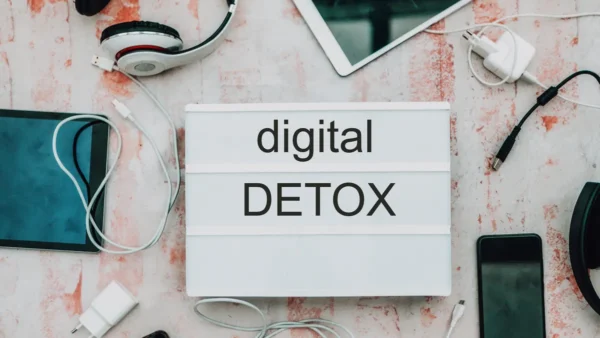
In a world where digital connectivity is both a necessity and a potential source of overwhelm, the concept of a digital detox is undergoing a profound transformation. What was once perceived as an extreme or ostracizing practice is evolving into a mainstream and balanced approach to well-being in 2024. This blog post explores the shifting perceptions surrounding digital detoxes, the driving forces behind this evolution, and why disconnecting from the digital realm is becoming a vital aspect of holistic self-care.
The Digital Dilemma
As our lives become increasingly intertwined with technology, the need for periodic disconnection has never been more apparent. The constant barrage of notifications, social media updates, and digital demands has led to a collective sense of digital fatigue. Recognizing the impact on mental health, relationships, and overall well-being, individuals are seeking reprieve from the digital deluge.
The Stigma of Disconnecting: A Shift in Perception
There was a time when taking a break from digital devices might have been met with skepticism or perceived as an antisocial act. However, the narrative is changing. In 2024, the stigma associated with digital detoxes is dissipating, making room for a more empathetic understanding of the need for balance in our tech-infused lives. Disconnecting is no longer viewed as an act of isolation but as a deliberate and commendable choice for self-care.
The Mental Health Imperative
The pervasive nature of digital connectivity has underscored the importance of safeguarding mental health. Digital detoxes are increasingly recognized as essential for combating digital burnout, reducing stress, and fostering a sense of mental clarity. As mental health takes center stage in societal conversations, the idea of stepping back from digital distractions is gaining legitimacy as a proactive measure for well-being.
Reclaiming Presence: Disconnecting to Connect
The paradox of our hyper-connected age is that, at times, we feel more disconnected than ever. Digital detoxes are emerging as a remedy, offering individuals the opportunity to reclaim presence in their lives. Whether it’s spending quality time with loved ones, engaging in outdoor activities, or simply relishing moments of solitude, disconnecting from the digital realm allows for a more authentic and meaningful connection with the world around us.
Balancing the Digital Diet: A Holistic Approach
The evolving perspective on digital detoxes is rooted in the recognition that balance is key. Rather than an all-or-nothing approach, individuals are adopting a more nuanced and holistic view of their digital consumption. It’s about curating a healthy digital diet that aligns with individual needs, allowing for intentional use without sacrificing well-being.
A Digital Renaissance
In 2024, the evolution of digital detoxes signifies a broader cultural shift—a renaissance in our relationship with technology. Disconnecting is no longer seen as an extreme measure but as a conscious and empowering choice. As individuals navigate the digital landscape with greater mindfulness, the concept of a digital detox becomes a tool for reestablishing balance, fostering well-being, and reclaiming a sense of agency over our digital lives. In the pursuit of a harmonious coexistence with technology, the digital detox has found its place not as an outlier but as an integral component of a holistic and mindful approach to modern living.

In the realm of unconventional wellness practices, the Wim Hof Breathing Method stands out as a powerful and transformative technique that has gained widespread attention. Developed by the Dutch extreme athlete Wim Hof, this breathing method combines specific breathing patterns, cold exposure, and meditation to unlock a range of physical and mental benefits. In this blog post, we’ll delve into the details of the Wim Hof Breathing Method, exploring how it works and the potential benefits it offers.
Understanding the Wim Hof Breathing Method:
At its core, the Wim Hof Breathing Method involves a series of deep, rhythmic breaths followed by a period of breath retention. The technique typically consists of three main phases:
- Breathing Exercise:
– Find a comfortable space to sit or lie down.
– Inhale deeply through the nose, filling the lungs with air.
– Exhale forcefully and completely through the mouth.
– Repeat this cycle for about 30 breaths.
- Retention Phase:
– After the final exhalation, take a deep breath in and let it out completely.
– Hold your breath for as long as you can comfortably manage.
– When you feel the urge to breathe again, take a deep breath and hold it for 15 seconds.
– Exhale and resume normal breathing.
- Cold Exposure:
– Incorporating cold exposure, such as ice baths or cold showers, is a key component of the Wim Hof Method.
– The cold exposure is believed to enhance the benefits of the breathing exercises, promoting improved circulation, reduced inflammation, and increased resilience.
How It Works:
The Wim Hof Breathing Method is based on the principles of controlled hyperventilation and conscious breath retention. The deep, rhythmic breathing helps to oxygenate the body, alkalize the blood, and activate the parasympathetic nervous system. This, in turn, can lead to a range of physiological and psychological effects, including:
- **Increased Energy Levels:**
– The enhanced oxygen intake may boost energy levels and reduce feelings of fatigue.
- Improved Immune Function:
– Wim Hof’s method has been associated with improvements in immune function, possibly due to reduced inflammation and increased production of anti-inflammatory cytokines.
- Enhanced Mental Clarity:
– Practitioners often report improved focus, concentration, and mental clarity after engaging in the breathing exercises.
- Stress Reduction:
– The method activates the parasympathetic nervous system, promoting relaxation and reducing stress levels.
- Mind-Body Connection:
– The combination of breathwork, cold exposure, and meditation fosters a stronger mind-body connection, empowering individuals to better regulate their responses to various stressors.
Conclusion:
While the Wim Hof Breathing Method has garnered considerable following and anecdotal evidence of its benefits, it’s essential to approach it with an understanding of individual variations and potential contraindications. Individuals with certain medical conditions should consult with healthcare professionals before incorporating the method into their routine.
Whether you’re seeking increased vitality, improved mental resilience, or a holistic approach to well-being, the Wim Hof Breathing Method offers a unique and accessible avenue to explore. As with any wellness practice, consistency and mindfulness are key, allowing individuals to discover the transformative potential within their own breath.
